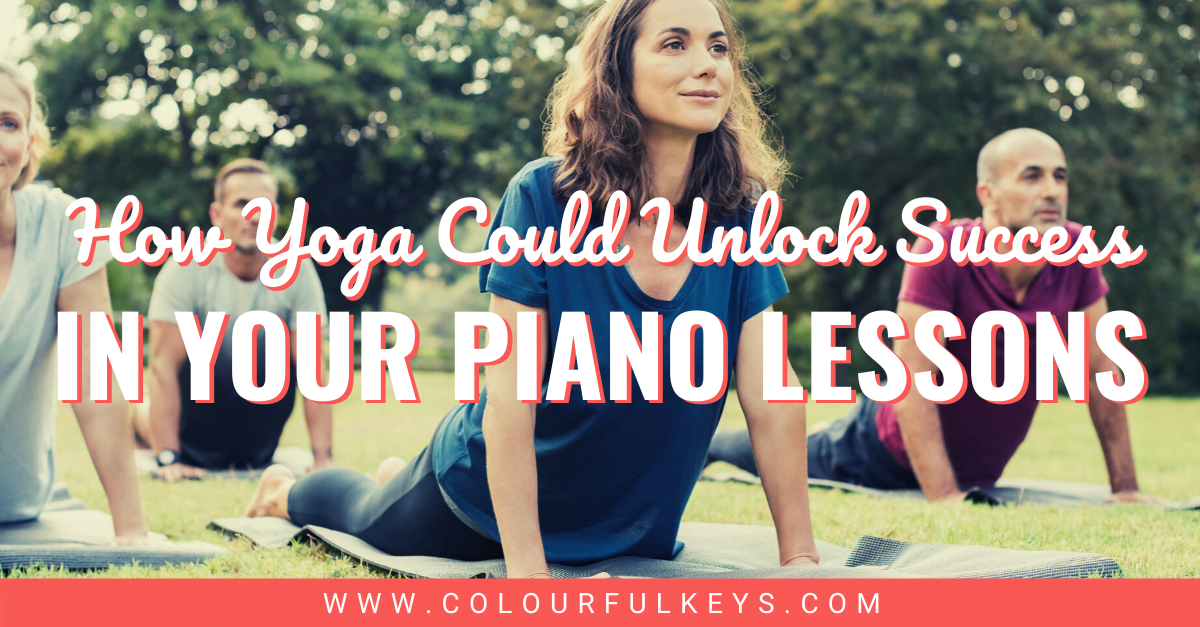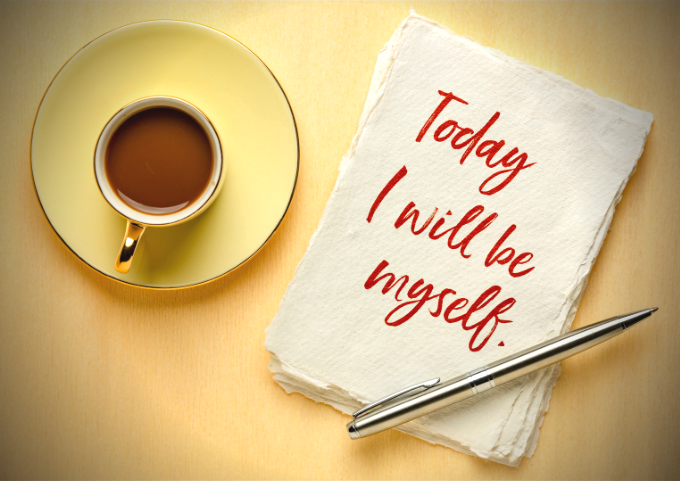Yoga is a fantastic tool for piano teachers and students, both in lessons and before home practice. It’s not only great to help calm and focus the mind – it can also help release tension and create a connection between the breath and the body.
In this article, I’ll share with you what I’ve learned from yoga. You’ll be able to use these tools even if you’ve never done a vinyasa or tadasana in your life. 🙂

⬆️ Listen to the podcast above or keep on reading, whichever fits your style. ↙️
I have done yoga almost every single morning for the past 5 years. You won’t see me doing any fancy arm-balances, but the poses and patterns have started to seep in during that time.
Whether or not you practice yoga yourself, I think there are lessons we can all take from it to apply to our studios.
I’ll divide these lessons into three sections, increasing the woo-woo factor as we go through the article so you can duck out if you need to. 😉
- Stretches
- Body Awareness
- Mantras and Mindfulness
I hope you’ll stick with me all the way to the end, of course. I think those last lessons are the most important for many of us (although the me of 10 years ago would have rolled her eyes at them.)
Yoga Lesson 1: Stretches
Piano technique can sometimes become very detached from the body. These yoga stretches are great to do with students at the start of our piano lessons. Come up with a combination which works for you, or mix it up each week!
Finger Flexes and Rotating Wrists
If you want to go beyond the usual finger stretches, you could try the lion pose:
- Sit on your knees with your feet together and knees wide.
- Turn your hands around so your fingers are pointing towards you.
- Put your palms on the ground.
Alternatively, this series of moves from Yoga with Adriene has lots of great options for wrists and fingers:
Artful Arms and Shining Shoulders
One simple way to warm up your arms is in the volcano pose:
- Stand with feet hip distance apart or flush together.
- Raise your arms up above towards the sky as if you’re holding a big beach ball over your head.
- Lean gently towards the left and then the right.
- Bring your hands together and slide them down to your heart.
Here’s another little ditty from Adriene, this time for shoulders, neck and back:
If you’re short on time in your piano lessons, members of Vibrant Music Teaching might like to use the One Minute Warmups from the VMT Printable Library. Many of these incorporate yoga stretches for arms, shoulders, and fingers.
Haven’t heard of the membership program yet? You’ve got to check it out – you won’t believe all the resources members have at their fingertips!
Brave Back
Back pain is actually the reason I got into yoga in the first place. My back and core used to be so weak that one ever so slightly wrong move and I could have back spasms for 3-5 days. That stopped after a few months of yoga, and I haven’t had to endure that pain since. ☺️
I think all the cobra poses made the biggest difference for me. But for your piano warmups, I’d like to suggest a simple forward fold and halfway lift.
- Forward fold, reaching down towards your toes.
- Raise halfway with your hands on your thighs or shins to make the shape of a 7 with your body.
- Forward fold again.
- Roll up slowing, stacking the spine vertebra by vertebra.
I like this yoga exercise for musicians during piano lessons and home practice, as it will get the blood flowing through the body a little more and establish good posture.
Here’s a quick video from Sarah Pilla to demonstrate the form:
Yoga Lesson 2: Body Awareness
So much of the time we move through the world without noticing all of the things our bodies are doing for us. I think the practice of yoga in piano lessons can give musicians more awareness of how we move and how our anatomy supports us.
It can also help us feel more positive about our bodies and reduce the impact of the ideas our bananas society has put in our brains about how we should look.
Regina Spektor says it perfectly in her song ‘Folding Chair’:
“I’ve got a perfect body, though sometimes I forget
Regina Spektor, ‘Folding Chair’
I’ve got a perfect body cause my eyelashes catch my sweat”
This might sound beyond the scope of piano lessons, but I don’t think it is. When you take care of your body because you know all it does for you, there’s less self-consciousness around planting your feet wide when sitting at the piano or analysing exactly how you should move to create the sounds you want.
Even just listening to a few yoga lessons will give you more vocabulary to frame our movements at the piano in this way.
Focusing on the functional use of our bodies is not utilitarian. It can actually be a more human experience and lead to more artistry at the piano – especially for our adult students.
For more tips on teaching technique to adult students and everyone else, visit my Planning Lessons hub page to read up on the latest and greatest.
Yoga Lesson 3: Mantras and Mindfulness
OK, I told you this post would get progressively more woo-woo so stick with me. 😉
When I started yoga, it was as a solution to back pain. I blocked out the mind and spirit sides of the practice just like I block out sports announcements on the radio. (Anyone else feel like they wake up from a trance when those end?)
I think I only really started listening to the talk about mantras and the power of thought when the global Covid-19 pandemic hit. And gosh, was I glad I finally listened.
Playing an instrument is as much a mental game as a physical one. I believe we should be giving our students all the tools at our disposal when it comes to preparing them to play in front of others or cope with stress.
Today I…
January 2021 was pretty tough for me. Nothing in particular happened, thank goodness. I was just really feeling the “down” part of the lockdown. I decided to try setting an intention each day and writing it in a spare diary I had. These were just simple “Today I…” statements, like:
- Today I take pride in my work.
- Today I will go for a long walk.
- Today I feel calm and kind.
Some of these statements came from yoga practices; some didn’t. Some are simpler and practical while others are feelings-based.

I didn’t commit to doing this practice forever, and I didn’t have a goal not to miss a day. I just wrote down something which made sense to me, when it felt right to do so. And I found it very helpful.
So what does this have to do with piano teaching?
Well, first of all, you might consider this practice for yourself. It may help ground you as it did for me, so I wanted to share it with you.
But more broadly, I’m thinking about how we could use this with students on a smaller scale. Many of our students dive into a piece without any forethought. Having them set an intention aloud before they begin playing might be a simple way to give them more focus.
Deep Breathing
Come back to the breath.
This is a good rule for dealing with everything from a scattered and hyper mind to stress to lethargy. Here are some simple breathing strategies to promote clarity of thought in your lessons and personal practice:
- Breathe in for a count of 4 and out for a count of 4. Picture drawing a square of light in the air with each count.
- Lie on your stomach and breathe into your belly so you feel it rise and fall. This is great for when you’re angry, anxious or are finding your breath is shallow and up in your chest.
- Breathe in and out with your tongue on the roof of your mouth and a soft restriction in the back of your throat so that you make an ocean sound. Here’s a video to demonstrate this.
- Place your hands on your belly and take a deep breath in. Breathe out sharply so your naval draws in. Do this quickly in succession, keeping the inhale passive and the exhale sharp. Here’s a video to show you how.
These breathing exercises (and many others) are something actionable you can do to bring more mindfulness to your piano studio. Try them out and see if your students’ mood shifts when you do. 😌
Which exercises do you encourage your students to do before each lesson?
I’d love to hear your thoughts on this in the comments below.

I can’t wait to try some of these ideas with two students who struggle with body awareness. It should be helpful for my ” robot” beginner who moves his elbow, arm, wrist, hands, and fingers as one unit. I also have an older “chicken” player whose elbows end up in the air by the end of every song. These activities should help him with spacial awarness.
Thanks for sharing,
It’s a very informative and interesting article.
I really enjoy your content.
q